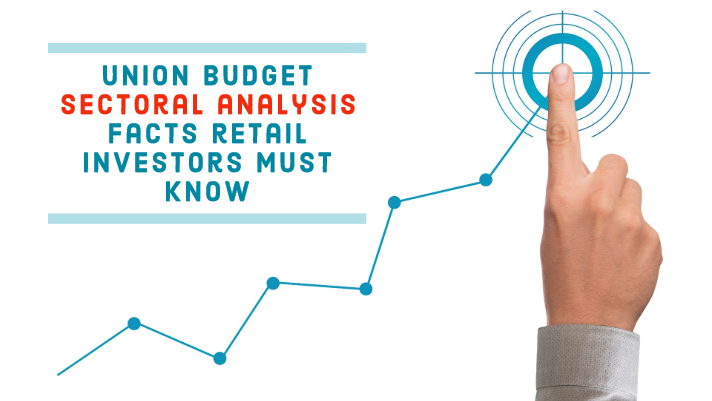Published : February 14, 2019

The union budget sectoral analysis is the most important aspect that investors have to see or take into consideration. We all know that the budget is the pillar of the economy. Union budget is the key source through which any government perform all its financial activities. Above all, it plays a vital role for investors and businesses.
We know that the budget keeps an account of revenue and expenditure for the government. The various departments under central government analyses the previous year budget to prepare a budget for the current year.
The government holds manifold power in the form of law and order. The government uses such power for maintaining the security of the national, enhancing stability and enacting reforms as part of social welfare. The budget system effectively allocates scarce resources to the various sectors of the economy.
The crucial objectives for the union budget in India are –
Heading further, in the current blog I will analyze the budget impact on few important sectors. While reading this blog article, you will get to know about a strong conviction for analyzing sectoral allocations by the union budget. Moreover, it will be easy for you to link them with your stocks investing.
In this article, I will be covering the banking & finance, auto & auto ancillary, agriculture, metal & mining, and oil & gas sectors.
Banking and finance sector is known as the backbone for any economy. So, the budget effect on banking and finance sector is crucial for the growth of any economy. Further, as an investor, I personally view the radical changes in the way the banking and financial institution of the country is working.
It is a fact that in the last few years in India, the banking sector has shown sudden growth in the activities. This was due to mainly by demonetization, goods and services tax and recapitalization of banks. These issues have to turn out to have a significant impact on the budget. As a result, it grabs special attention in the union budget. This sector is performing good in recent times.
Furthermore, the continuation of demand in various government schemes is driving higher growth in the economy. All such schemes are put to act mainly through the banking and financial institution network in the country. Thus, very crucial for the success of this sector’s business as a whole.
Now, let us focus on a few interesting aspects in the Indian banking & finance sector for a stock market investors point of view.
When you will dig into the history, you will find that since independence, the Indian government focuses was on economic growth. Along with it, the focus is also on the growth of its citizens. This is done by introducing various schemes. Social schemes especially for farmers, for below poverty line, for the middle class, etc.
This sector was quiet crucial after and before introducing two bigger reforms that were demonetization and goods and services tax. To elaborate more on this sector we will try to explain a few reforms made by the central government.
Any government initiate such step to seize or ban the ongoing status of the currency unit as a legal tender. Demonetization does affect the stock market too in a broader way. This is evident from the latest demonetization drive by the Indian central government in Oct 2016. Both the indices drop to their six month low in the week just after the announcement. BSE Sensex fell by 1689 points and Nifty 50 over 541 points.
However, the impact of demonetization on the stock market is temporary. Yet the prices of stocks fluctuate wildly after such announcements. Additionally, it is true that demonetization did not affect each and every sector. So, if you invest in any such immune sectors, you do not own to worry.
At the same time, it gives an opportunity to investors and speculators. Stocks are available cheap due to short term panic in the market. So you may get a chance to purchase quality stocks at a lower price. Notwithstanding, they are temporary and recover with more money in circulation in due course.
The impact of GST on the stock market in India is immense. The implementation of GST help improves the way of doing business in the country. This is because it has an idea of all tax under one umbrella. It also shows to be boon for businesses. As it deals with multiple levies within the country.
At the same time taking into consideration, the rules of this reform prove to be beneficial for investors in long run. In the case of the short run, it was neutral to negative. Although, the first quarter had a negative effect due to chaos and confusion related to the GST regime.
This kind of drastic decision of government does make banking sector perform well or the other way. Such a decision which is commonly made public through budget announcements are very helpful for retailers. As because there is plenty of time in between announcement and its implementations. So you as an investor have lots of time to readjust your investments or for planning for the same in this particular sector.
The business growth of the auto and auto ancillary sector is directly dependent on infrastructure growth. This is a true face to any economy. And it is also a fact that the major population of India still resides in rural areas. So the government is very curious to push for revitalizing the rural economy and improving economic development.
This idea is taken forward through improving infrastructure connectivity. Thus, the government always give some additional weight on pushing infra projects in every yearly budget. Plus one of the direct beneficiaries is auto and auto ancillary companies. Good infrastructure means more retail investments on both personal and private vehicles.
Thus, we need to analyse the budget effect on the auto and auto ancillary sector in light of infrastructure development in the country.
Over the years, the main focus of the budget is to increase income for rural areas. This acts as catalysts to the automobile demand. Automobile demand from rural areas, especially two-wheelers and tractors.
Further, this ongoing government plan went on ever investing rise in agriculture growth as well. The government also ensure for the support price to maintain at least 1.5 times to cost of production.
Moreover, linking farmers with the electronic marketplace and the availability of cheap credit is impacting rural income. This is also highly positive for tractor manufacturers, two-wheelers and the utility vehicles.
Furthermore, the central government or the budget plan usually focus on improving the road network and execution of road projects. No one can deny a positive impact on the automotive industry in the long term was also seen.
In order to give a strong boost to Indian local manufacturers of auto ancillary sector government has taken drastic steps. One such step is raising import duty on auto components in the recent budget announcement. For some specific categories of automotive components, there is an increase in the import duty to 15%. Distinctively automotive components such as engines, silencers, engine components, brakes, radiators, etc., earlier have customs duty of 7.5% or 10%.
This is a very much clear indication that the government is backing strongly the “Make in India” program for the automotive industry too. Besides, through budgetary initiatives, the government is also promoting the localization of many ongoing vehicle programs.
For instance the imports duty on motor cars, motor vehicles and motorcycles has got a rise from 10% to 15% too. The purpose was simply to encourage auto manufacturers to incentivize for local sourcing of components.
In addition, there is an increase in the duty of the import of motor vehicles that have the capacity of ten seaters. Also, the motors for the transport of goods under completely built unit (CBU) is seen attracting 25% basic customs duty. Earlier the customs duty was 20%.
Furthermore, there is an abolition of the 3% cess on customs duty. In its place, a new levy of 10% was introduced. Such social welfare surcharges have a dual role to play. It helps to increase the customs duty on imports. At the same time, it helps domestic auto and auto ancillary manufacturers passively.
“The union Budget impact sectors heavily in India. Industries perform mainly on the overall policy and guidelines laid down by the government. If you are new to stock market investing read our exclusive blog coverage on the basics of how to analyse budget for the same. “
Thus, from above it is clear that the union budget overall focuses on the basic building blocks of the economy. Say it, whether its upliftment of rural population, agriculture improvement, building infrastructure or easing MSMEs rules and regulations for more and more employment generation. All, the budget takes care off.
All these budgetary efforts for sure help increase demand for the Indian automotive sector as a whole. The mandate of local sourcing requirement also holds favourable to Indian automotive ancillary and supplier industry.
India still is an agrarian economy. Since independence, the Indian union budget stands strong on market reforms in the agriculture sector. The key areas where government focus through budget initiatives are crop insurance and farm credit. Along with this the budget also stresses on improving irrigation facilities and developing the dairy sector.
Further, it is important to note that mostly through various schemes the government provides budgetary support to the agriculture sector in India. For instance, there is a crop insurance scheme for the government of India. You can sense how government allocates funds through such schemes by the fact that the Pradhan Mantri Fasal Bima Yojana, there is an increase in allocation from INR 5500 crore (2016-17) to INR 9000 crore approximately, a year after. The government also plans to increase this up to 50% in the next few years.
In a similar line, the government also funds heavily to improve irrigation in the country through budgetary support. For instance, the government kept aside an additional fund of INR 20,000 crore for the long-term irrigation fund in recent budget announcements.
Furthermore, under NABARD, the budget helps setting up of micro-irrigation fund with INR 5000 crore support. Besides, the government dedicates INR 8000 crore for dairy development under NABARD in the recent budget as well.
Keeping all this in mind, as an investor you must consider these stocks while analysing the budget effect on the Indian agriculture sector. You must explore investing in stocks associated with the farm and agriculture sector. Stocks of the companies like Dhanuka Agritech, Shakti Pumps, Kaveri Seed Company, Monsanto India, Jain Irrigation and etc. This will help your portfolio stability along with consistent long term growth.
Metal and mining are among the largest employability sector in India. Besides agriculture, this sector is the major driver of economic growth in the country. Furthermore, she is prime precedence in the cost of production of steel and alumina in the world.
India is among leading in the production of 95 minerals, 4 fuel related minerals, 3 atomic minerals,10 metallic minerals, 23 non-metallic minerals, and 55 minor minerals. The driving force behind the growth of this sector is the growing infrastructure development and rising automobile production. In addition, there are ever-growing power and cement industries too.
In recent years, India stands third across the world in coal production and fifth in the world coal reserves. Further, globally, India stands fourth when it comes to iron ore production and contributes approximately 8% to iron ore deposits. Plus, when it comes to steel, she stands third in crude steel producer across the world. India also has large deposits of bauxite.
Being a sector with strategic importance, the government also take special care of it. Every yearly union budget has some announcements for this specific sector. For instance, the government now allows for up to 100% FDI in the mining of metals and nonmetals.
Furthermore, the Government of India has various yearly plan measures to stimulate the country’s domestic steel sector through budgetary support. There is a plan to raise the steel production capacity to 300 million tons by 2030-31.
So, companies with FDI approvals have a positive impact on their respective share prices. Furthermore, it is not wrong to expect that the demand for iron and steel in the country is peaking. Furthermore, strong growth in residential and commercial property will also support the sector. Look for any such announcement, especially during the budget sessions while analyzing the budget impact on the metal & mining sector in India. Pay special attention to Tata Steel, Kalyani Steel, JSW Steel, SAIL, Coal India and etc.
In the list of core industry, next fall’s oil and gas sector in India. The decisions and policies made in this sector often seen to influence other sectors in the economy. There is a close relation in energy demand and economic growth of India.
The government is taking several drastic measures to fulfil the rising energy demand of the country. Lots of segments under this sector can now have 100 % FDI. Segments like petroleum products, natural gas, and refineries. This helps raise both domestic and foreign investment, which is key to the growth of the sector.
India retained the spot as a third largest consumer of oil in the World in 2017. India states as the rank of fourth as a Liquefied Natural Gas (LNG) importer in 2017 after Japan, South Korea, and China.
Through the budget, the government takes various Initiatives which help promote the oil and gas sector in the country. For example, for the gas pipeline network expansion in the country, the government had an investment plan of around INR 70000 crores in the next few years.
“It is true that you do not invest directly into sectors. … In India, the union budget is the annual financial statement of accounts of the …”.
Read our exclusive coverage on analysing the budget impact on a few more sectors in the following blog article –
There are also fiscal incentives to attract investments along with technology in the sector. This is mainly to improve recovery from oil fields. Moreover, there is also a gas exchange plan. This will bring market-driven pricing in the Indian energy market.
With all these budget measures of the government, the energy demand in the country is seen to grow by 11% in 2040 from 5.58% in 2017. Furthermore, the growth of crude oil consumption is seen at CAGR of 3.60% by 2040. It is from 221.76 million tonnes in 2017. In the case of natural gas consumption, it is seen to grow at a CAGR of 4.31% by 2040. The numbers stand 54.20 million tonnes in 2017.
Thus while examining the impact of the budget on oil & gas sector in India, you need to consider such details. All such initiatives are very positive for OIL, BPCL, ONGC and Reliance Industries.
Hereby, concluding I must admit that you can use the union budget as a tool for investment. However, for that, you will need to analyze the impact of the budget on different sectors deeply. As it is a powerful tool for the government to control the economy, similarly, it acts as a powerful prediction tool for investors.
Nonetheless, when you analyze the sector from government initiatives point of view, you are at less risk. Risks in terms of your long term returns from such investments.
Do not forget that these sectors are the main focus of the government. This is because they drive major growth in the economy. Almost all the sector generates the highest revenue. Therefore, as an investor in these sectors, you can see your investment risk minimizing. You can earn a higher profit from your investments. Your main concerns should be to keep checking the tax rates, and imports and exports to judge whether such sector is favourable or not at any particular point of time.
“Grab budget 2019 live updates and announcements here. The key highlights are there for your ready reference on Indian union budget 2019…”

Enjoy flexible trading limits at
lowest brokerage rates ?
Open Your Investments Account Now
0Account Opening Charges
Life Time Demat AMC
Brokerage







Ensure the security of your investments by updating your nominee details in your trading & demat account online. It’s quick and hassle-free!
📌 Act Now to Stay Compliant
For assistance, contact our Customer Care at 0562‑4266666 and email askus@rmoneyindia.com.

IT'S TIME TO HAVE SOME FUN!
Your family deserves this time more than we do.
Share happiness with your family today & come back soon. We will be right here.
Investment to ek bahana hai,
humein to khushiyon ko badhana hai.
E-mail
askus@rmoneyindia.com
Customer Care
+91-9568654321